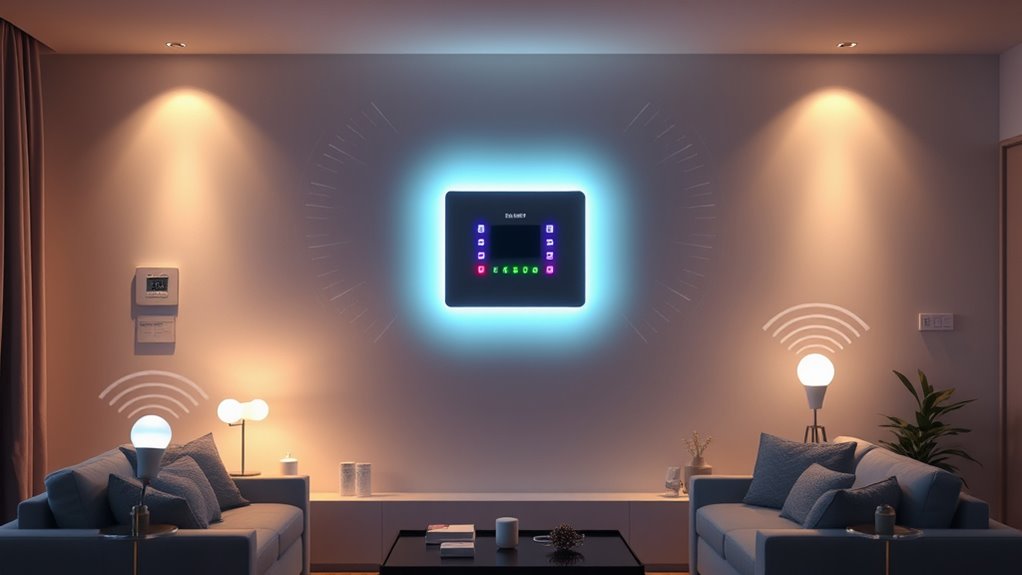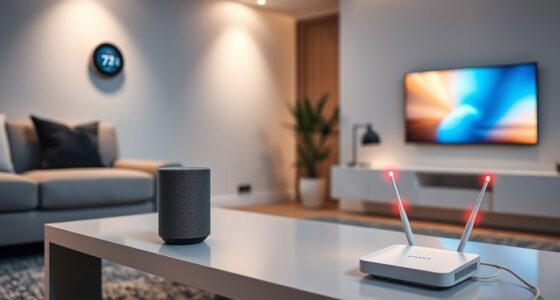When choosing between Zigbee, Z-Wave, and Wi-Fi for your smart home, consider coverage, power use, and security. Zigbee and Z-Wave excel in low power consumption and mesh networks, making them great for sensors and locks, while Wi-Fi offers faster speeds and broader coverage but drains batteries quicker. Security features vary across protocols. To guarantee smooth setup and future-proof your system, understanding these differences helps—stay with us to learn more.
Key Takeaways
- Zigbee and Z-Wave are low-power, mesh protocols ideal for device communication and extended coverage, while Wi-Fi offers high bandwidth for streaming and large data transfer.
- Zigbee operates at 2.4 GHz with multiple channels, Z-Wave around 908 MHz in the US, and Wi-Fi typically uses 2.4 GHz or 5 GHz, affecting range and interference.
- Zigbee and Z-Wave support easier setup and better battery life for sensors, whereas Wi-Fi provides broader compatibility but consumes more power.
- Wi-Fi handles high-speed, real-time responses for multiple devices, while Zigbee and Z-Wave prioritize reliable, low-latency device control within mesh networks.
- Security varies across protocols; Wi-Fi with WPA3 is highly secure, while Zigbee and Z-Wave also offer robust encryption and device authentication.
Understanding Wireless Communication in Smart Homes
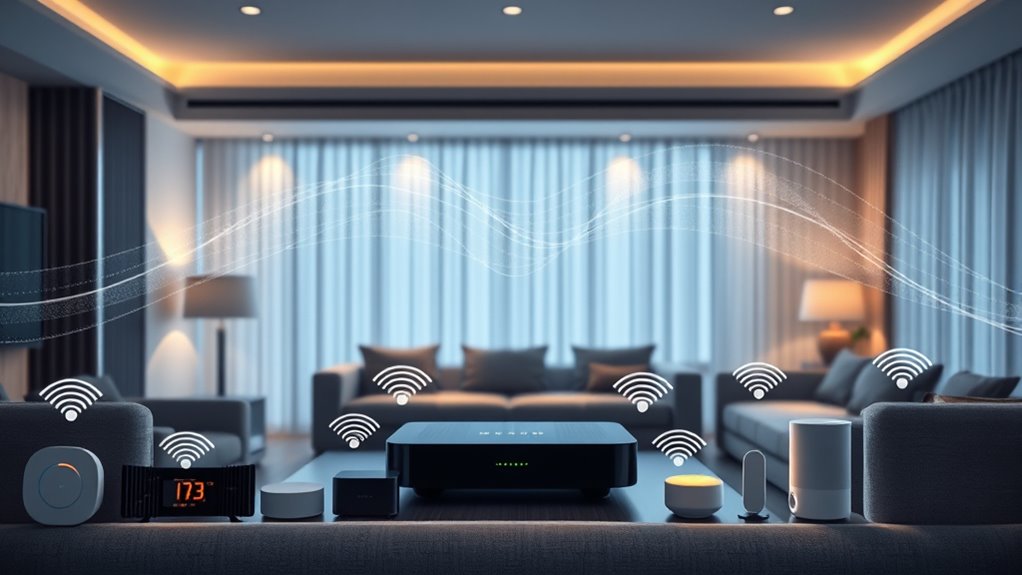
Have you ever wondered how your smart home devices communicate seamlessly? It all comes down to wireless communication protocols that enable devices to connect and work together effortlessly. When you use voice control, your commands are transmitted securely through these protocols, ensuring your privacy. Data encryption plays a crucial role here, protecting your information from potential eavesdroppers and unauthorized access. These protocols create a reliable network that supports real-time responses, so your lights turn on instantly or your thermostat adjusts smoothly. Understanding how your devices communicate helps you appreciate the importance of secure, efficient data transfer. Whether it’s Zigbee, Z-Wave, or Wi-Fi, each protocol employs encryption to keep your smart home safe while maintaining smooth, responsive control. Additionally, AI security technologies are increasingly integrated into these protocols to enhance threat detection and safeguard your smart home ecosystem.
The Core Technologies Behind Zigbee and Z-Wave
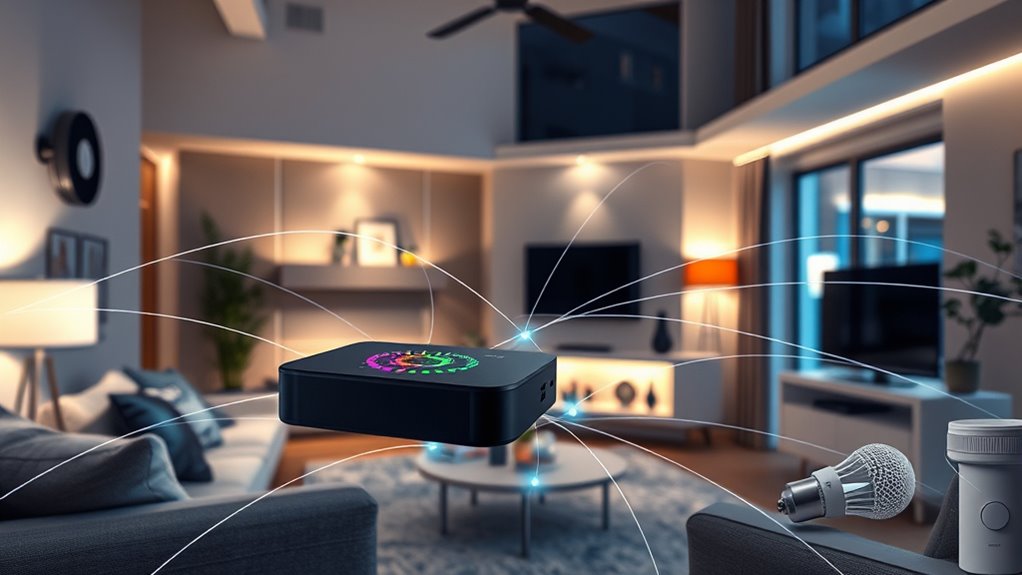
Zigbee and Z-Wave operate on different network protocols and frequencies, which affects their range and interference resistance. Their mesh networking capabilities enable devices to communicate directly with each other, creating a robust and scalable system. Understanding these core technologies helps you choose the right protocol for your smart home setup. Additionally, the security features of each protocol vary, impacting how well they protect your network from unauthorized access.
Network Protocols and Frequencies
Network protocols and frequencies form the backbone of smart home communication, enabling devices to reliably exchange data with minimal interference. Different devices operate on specific frequency bands, like 2.4 GHz or sub-GHz, which influence range and signal stability. Protocol standards, such as Zigbee’s and Z-Wave’s, define how devices communicate, ensuring compatibility within their networks. Zigbee typically uses the 2.4 GHz band with multiple channels, while Z-Wave operates at around 908 MHz in the US, reducing congestion. These frequency choices help minimize interference from Wi-Fi and Bluetooth, improving reliability. Understanding these core technologies allows you to better grasp how devices stay connected and communicate smoothly in your smart home ecosystem. Additionally, high refresh rates and low latency are crucial for real-time responsiveness in smart home automation, especially for security and interactive features.
Mesh Networking Capabilities
What makes Zigbee and Z-Wave particularly reliable for smart home communication is their use of mesh networking technology. This setup allows devices to connect directly with each other, creating a resilient network that can reroute signals if a device drops out. Mesh networks enhance device interoperability, meaning different devices can communicate seamlessly regardless of manufacturer. Additionally, they support protocol scalability, so your system can grow without losing performance or coverage. Each device acts as a node, extending the network’s range and reliability. This decentralized approach reduces latency and minimizes the risk of a single point of failure. Moreover, safety in shark-infested waters is a critical consideration when exploring underwater environments, and mesh networking’s robustness can be likened to the safety measures divers employ in high-risk areas, ensuring continued connectivity even if some nodes fail. Ultimately, mesh networking ensures your smart home remains responsive, flexible, and easy to expand over time.
How Wi-Fi Facilitates Smart Device Connectivity
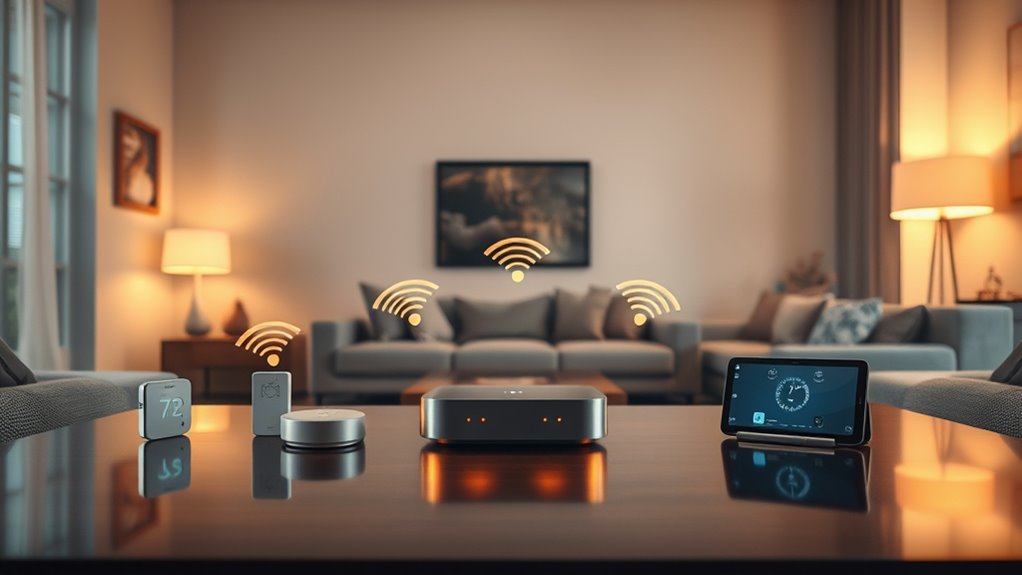
Wi-Fi makes it easy for your smart devices to connect seamlessly to your home network. It handles high bandwidth and fast speeds, supporting multiple devices at once. Plus, its broad compatibility guarantees most smart gadgets can join your network without issues. Additionally, Wi-Fi can be optimized for specific smart devices through performance tuning, ensuring smoother operation and better reliability.
Wireless Network Integration
Ever wondered how your smart home devices stay connected seamlessly? Wi-Fi plays a vital role in wireless network integration by providing a reliable platform for your gadgets to communicate. It handles interference management effectively, minimizing disruptions from other wireless devices and ensuring smooth operation. When setting up new devices, you benefit from straightforward device pairing, which quickly establishes secure connections without complicated processes. Wi-Fi’s widespread compatibility makes it easy to add and manage multiple devices through your existing network. This connectivity allows for real-time control and updates, enhancing your smart home experience. Additionally, the interference management capabilities of Wi-Fi help optimize performance even in environments with numerous wireless signals. By leveraging Wi-Fi’s robustness, your devices stay synchronized, responsive, and ready to serve your needs without interruption.
Bandwidth and Speed
Have you noticed how quickly your smart devices respond when your Wi-Fi connection is strong? That’s because Wi-Fi offers higher bandwidth and faster speeds compared to other protocols like Zigbee or Z-Wave. Bandwidth limitations can slow down device performance, especially when many devices are connected simultaneously. To maintain smooth operation, speed optimization becomes essential; this involves prioritizing traffic or upgrading your router. A robust Wi-Fi connection guarantees your smart home runs seamlessly, enabling quick commands and real-time updates. Unlike protocols with restricted bandwidth, Wi-Fi handles data-heavy tasks effortlessly, supporting streaming, security cameras, and other high-demand devices. Ultimately, a strong Wi-Fi connection allows your smart home ecosystem to operate efficiently without lag or interruptions.
Device Compatibility
A strong Wi-Fi connection not only boosts speed but also broadens compatibility among your smart devices. Wi-Fi supports a wide range of interoperability standards, allowing devices from different brands to work together seamlessly. Plus, many manufacturers rely on simplified device licensing, making setup easier without worrying about proprietary restrictions. With Wi-Fi, your devices don’t need special hubs or bridges, reducing compatibility issues. This means you can connect smart thermostats, cameras, and lights directly to your network. Here are some benefits:
- Easy integration with existing home networks
- Compatibility with most smart home apps
- No need for additional hubs or controllers
- Supports high data transfer for multimedia devices
- Simplifies adding new devices over time
This flexibility makes Wi-Fi a practical choice for a versatile, interconnected smart home network interoperability.
Range and Coverage: Which Protocol Reaches Further?
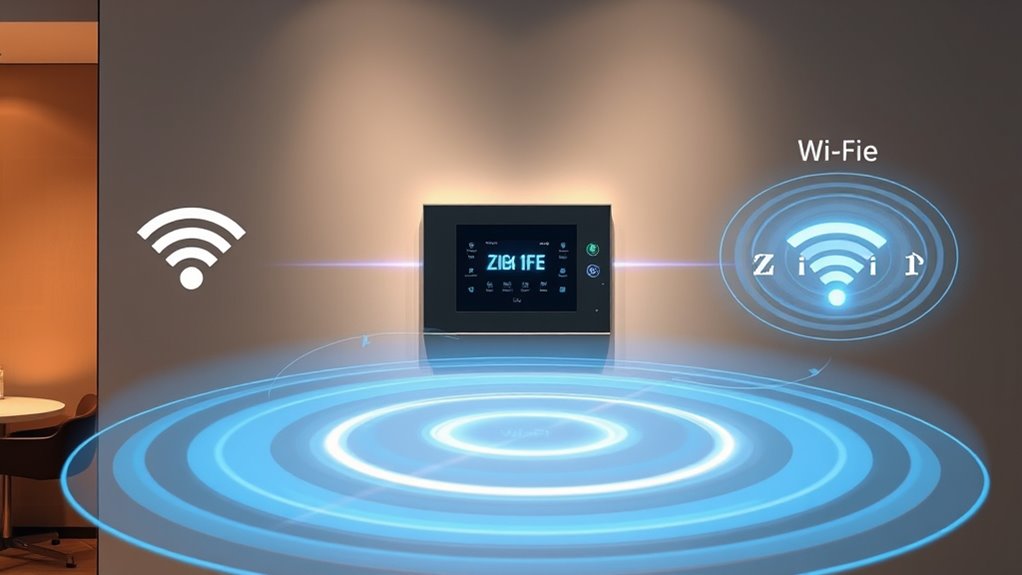
When comparing smart home communication protocols, understanding their range and coverage is essential, as it determines how effectively devices stay connected throughout your home. Zigbee generally offers a range of about 10-20 meters indoors, but its protocol scalability allows multiple devices to form mesh networks, extending coverage considerably. Z-Wave typically reaches up to 30 meters indoors and also supports mesh networking, which helps handle device diversity across larger areas. Wi-Fi provides the broadest coverage, often exceeding 30 meters indoors, depending on your router’s strength. Since Wi-Fi supports a vast number of devices, it excels in scalability, ensuring your entire home remains connected. Overall, Wi-Fi reaches further in coverage, but Zigbee and Z-Wave excel in building reliable, scalable networks within smaller or more complex spaces. Automation integration improves network efficiency and device coordination, making smart home systems more seamless and responsive.
Power Consumption and Battery Life Considerations
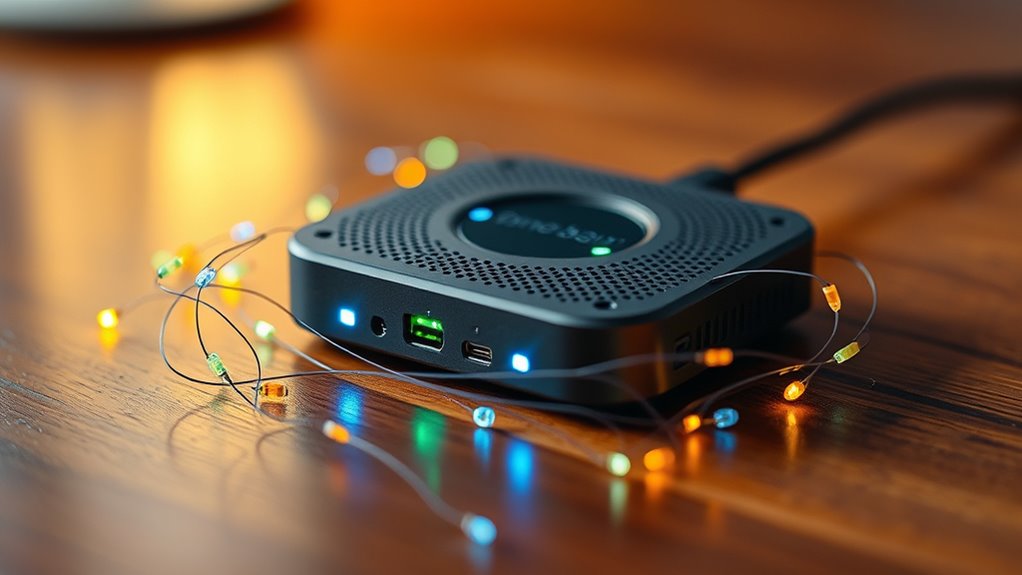
While Wi-Fi offers extensive coverage suitable for large homes, its higher power consumption can be a drawback for battery-powered devices. To maximize battery efficiency, you need to contemplate how each protocol manages power. Z-Wave and Zigbee excel here with low power modes, extending battery life for sensors and locks. Wi-Fi devices often drain batteries faster due to constant data transmission, requiring frequent replacements or recharging. Additionally, filter maintenance for air purifiers demonstrates how regular care can improve device longevity and performance, similar to managing smart home devices effectively.
Compatibility and Ecosystem Integration

You might find that different smart home devices don’t always work seamlessly together, creating interoperability challenges. Ecosystem lock-in can limit your choices, making it harder to switch brands or platforms later. Device compatibility issues can also restrict what you can add to your setup, potentially forcing you to stick with certain brands or protocols.
Interoperability Challenges
Interoperability challenges in smart home communication protocols stem from the diverse range of devices and standards that often fail to seamlessly work together. You might find yourself frustrated, stuck with incompatible gadgets or locked into specific ecosystems. These issues arise because manufacturers prioritize their proprietary standards, leading to vendor lock-in, and hinder broad compatibility. Despite ongoing standardization efforts, many protocols remain isolated.
Consider these common hurdles:
- Limited device compatibility
- Fragmented ecosystems
- Increased complexity in setup
- Dependence on specific hubs or bridges
- Higher costs due to multiple protocols
To overcome these challenges, you need to understand each protocol’s strengths and limitations. Recognizing vendor lock-in and supporting standardization efforts can help you choose devices that play well together, simplifying your smart home experience.
Ecosystem Lock-In
Have you ever felt stuck with a limited smart home setup because your devices only work within a specific ecosystem? That’s ecosystem lock-in, where your choices become constrained by vendor dependency. When you commit to one ecosystem, switching later can be challenging, costly, or even impossible without replacing devices. This vendor dependency means you might miss out on better features or more affordable options from other brands. It’s easy to become tied to an ecosystem’s ecosystem-specific hubs, apps, and integrations, which can limit your flexibility. While sticking with one vendor might simplify setup, it also restricts your ability to expand or upgrade seamlessly. Recognizing ecosystem lock-in helps you make smarter choices now, avoiding future frustrations and keeping your options open. Additionally, understanding the compatibility between devices ensures smoother integration and future-proofing your smart home investments.
Device Compatibility Limits
Device compatibility limits can pose significant challenges when integrating smart home products, especially if devices are designed to work best within specific ecosystems. Regional restrictions, such as frequency regulations, can prevent devices from functioning properly in certain areas. Manufacturer diversity also means not all devices are compatible, forcing you to stick with one brand or ecosystem. You might encounter issues like:
- Limited device options within your chosen ecosystem
- Incompatibility between Zigbee, Z-Wave, and Wi-Fi devices
- Need for hubs or bridges to connect different protocols
- Firmware updates that break compatibility
- Regional restrictions limiting device use abroad
These factors can complicate building a seamless smart home, requiring careful planning and awareness of ecosystem limitations. Understanding these compatibility issues helps you make smarter choices when expanding your smart home setup.
Security Features in Zigbee, Z-Wave, and Wi-Fi
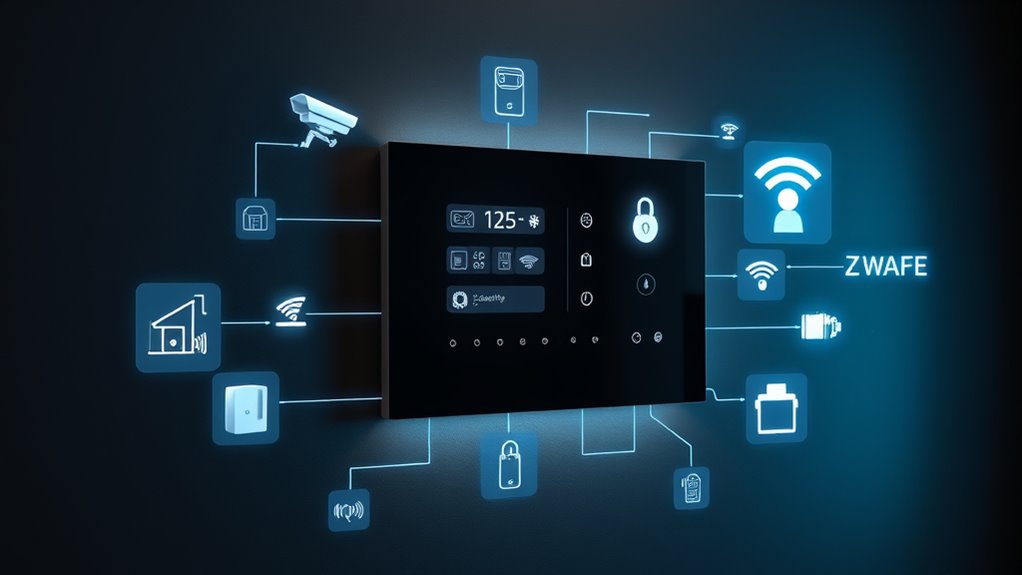
How secure are the communication protocols that keep your smart home safe? Zigbee, Z-Wave, and Wi-Fi each use security encryption to protect your data from eavesdropping and tampering. Zigbee and Z-Wave implement robust security encryption methods, making it difficult for hackers to intercept or decode signals. They also rely on device authentication, ensuring only trusted devices can join the network. Wi-Fi, especially with WPA3, offers strong encryption and authentication features, providing a secure connection for your devices. However, Wi-Fi networks can be vulnerable if not properly secured with strong passwords and updated firmware. Overall, all three protocols prioritize security, but maintaining best practices, like regular updates, is essential to keep your smart home safe.
Setup and Ease of Use for Different Protocols
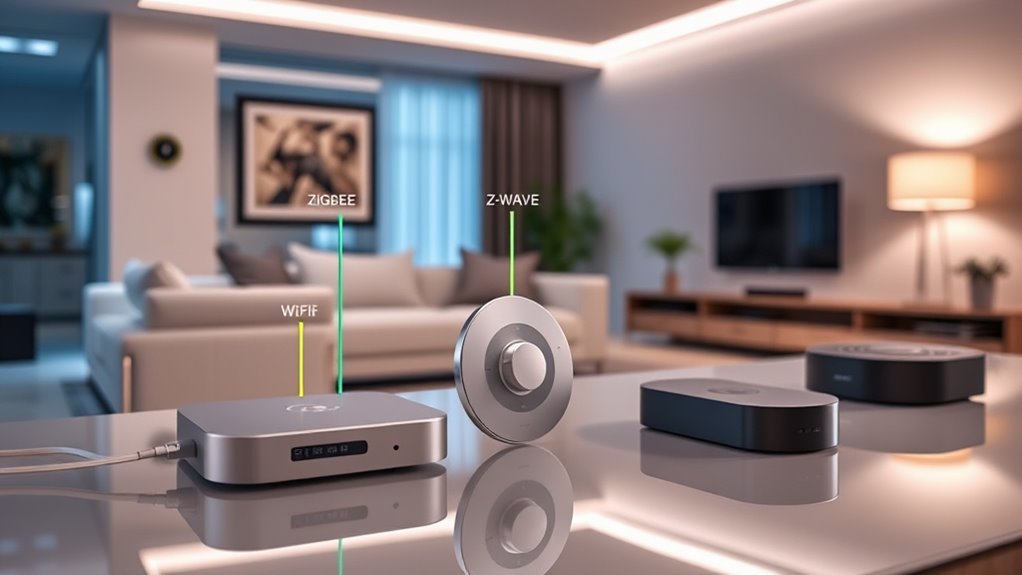
Setting up and using different smart home communication protocols varies in complexity, but generally, Zigbee and Z-Wave are designed to be user-friendly with straightforward installation processes. You’ll find that pairing devices often involves simple steps through a dedicated hub or app, with minimal technical knowledge needed. Wi-Fi devices might require more configuration, especially when connecting to your network and optimizing the user interface. Voice control integration is usually seamless across protocols, enabling hands-free operation.
Zigbee and Z-Wave are user-friendly, with simple setup; Wi-Fi may need more network configuration.
- Zigbee and Z-Wave often feature intuitive apps for setup
- Wi-Fi devices may need more network adjustments
- User interfaces are designed for easy navigation
- Voice control setup is quick with compatible devices
- Overall, each protocol aims for a smooth, hassle-free experience
Future-Proofing Your Smart Home Investment

To guarantee your smart home remains functional and adaptable as technology evolves, it’s essential to select communication protocols that are future-proof. Opt for systems that support voice control and seamless device automation, ensuring compatibility with new devices and updates. Zigbee and Z-Wave are strong contenders because they’re designed to work across various brands and are regularly updated for security and performance. Wi-Fi, on the other hand, offers broad compatibility and easy integration with existing home networks. Consider choosing a protocol that allows for easy expansion and quick integration of new devices. Future-proofing also means keeping an eye on emerging standards and ensuring your setup can support voice control features and advanced automation, so your smart home remains flexible and ready for what’s next.
Making the Best Choice for Your Smart Home Needs

Choosing the right smart home communication protocol depends on your specific needs and priorities. If you want seamless voice control, look for protocols with strong compatibility with voice assistants. For energy efficiency, Zigbee and Z-Wave are excellent choices, as they consume less power and operate on secure, low-bandwidth networks. Consider your home size and device count—Wi-Fi handles high data loads but can strain your network. Think about future upgrades and device compatibility to avoid costly replacements. Finally, evaluate your security preferences, since different protocols offer varying levels of encryption.
Here are some tips:
- Prioritize voice control compatibility for easier automation
- Choose energy-efficient protocols to save power
- Consider your home size and network capacity
- Ensure device compatibility and future-proofing
- Balance security features with your privacy needs
Frequently Asked Questions
Can These Protocols Work Together in the Same Smart Home System?
You wonder if these protocols can work together in your smart home. While it’s possible to integrate devices, interoperability challenges often arise due to protocol compatibility issues. You may need a smart hub or bridge to connect different systems, but be aware that some devices might not communicate seamlessly. To guarantee smooth operation, research compatibility options and consider choosing devices that support multiple protocols or use a unified platform.
Which Protocol Offers the Best Security Against Hacking?
Imagine a hacker targeting your smart home. You’d want the highest security, right? Protocols with robust encryption standards and regular firmware updates offer better protection against hacking. For example, Z-Wave emphasizes encryption and frequent updates, making it harder for intruders to breach. You should choose a protocol that prioritizes security features like encrypted communication and stays current with firmware patches to keep your devices safe.
Are There Cost Differences Between Zigbee, Z-Wave, and Wi-Fi Devices?
When comparing device costs, you’ll notice differences based on compatibility and power consumption. Devices with broader compatibility might be pricier but are easier to integrate across systems. Lower power consumption can also influence costs, as energy-efficient devices tend to be more expensive upfront but save money over time. Overall, consider your budget and needs, as these factors directly impact the initial investment and ongoing expenses of your smart home setup.
How Do These Protocols Impact Overall Smart Home Network Performance?
You might wonder how these protocols affect your smart home network. They influence performance through interference management and bandwidth optimization. Efficient protocols reduce signal interference, ensuring reliable connections, while optimizing bandwidth prevents network congestion. This means your devices work smoothly without lag or dropouts. Overall, choosing the right protocol can substantially improve your smart home experience by maintaining a fast, stable, and responsive network.
What Are the Maintenance Requirements for Devices Using Each Protocol?
You might worry maintenance is complicated, but it’s manageable. Devices generally require periodic firmware updates to fix bugs and improve security, and battery life varies—some last months, others need frequent charging or replacement. Regularly check for updates and replace batteries as needed, but overall, keeping your smart devices running smoothly doesn’t demand much effort. Staying on top of firmware updates ensures your devices stay secure and perform efficiently without hassle.
Conclusion
Choosing between Zigbee, Z-Wave, and Wi-Fi depends on your smart home needs. Each has its strengths, so don’t put all your eggs in one basket. Consider your devices’ range, power needs, and security. Remember, it’s better to cut to the chase now than deal with headaches later. By understanding these protocols, you’ll be able to build a smart home that’s truly future-proof and tailored just for you.
